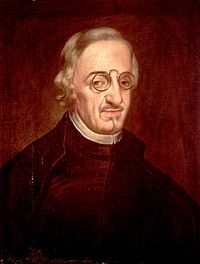Tomas de Aguiar facts for kids

Tomás de Aguiar was a Spanish painter who lived a long time ago, during a period called the Baroque (around the 1600s). He was especially good at painting portraits, which are pictures of people. He even learned from a very famous painter named Diego Velázquez.
Tomás de Aguiar: A Talented Painter
Tomás de Aguiar was a Spanish artist who lived in the 1600s. Not much is known about his early life. We do know he was a student of the famous painter Diego Velázquez. This connection made him a respected artist.
A historian from the 1600s, Lazaro Diaz del Valle, wrote about Aguiar. He said that in 1657, Aguiar was working for the Duke of Arcos. Diaz del Valle also mentioned that Aguiar was "excellent at taking natural portraits." This means he was very good at making paintings look like the real person.
Another writer, Juan Agustín Ceán Bermúdez, also praised Aguiar's skill. He noted that Aguiar painted "with great credit" in the 1660s. This shows that Aguiar was well-regarded for his work.
Aguiar's Famous Friends
Tomás de Aguiar had connections with important people of his time. The poet Gabriel Bocángel wrote about him in 1653. This suggests that Aguiar was a well-educated gentleman.
His connection to Velázquez is also shown in Velázquez's belongings. When Velázquez passed away in 1660, a list of his possessions was made. This list included a portrait of "Don Tomás de Aguiar." This painting is now lost, but it shows how close they were.
A famous writer and historian named Antonio de Solís y Ribadeneyra also spoke highly of Aguiar. He called him "a distinguished painter, and great Courtier." Solís even wrote a special poem, called a sonnet, for Aguiar. He wrote it after Aguiar painted a portrait of him. This shows how much Solís admired Aguiar's painting skills.
Tomás de Aguiar passed away in Madrid, Spain, around the year 1679.
See also
 In Spanish: Tomás de Aguiar para niños
In Spanish: Tomás de Aguiar para niños

